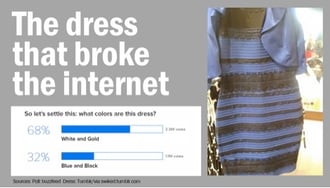Remember “The Dress that broke the internet”? Back when my son was 23, he showed me a picture on his phone and asked me what I thought was an odd question: “Dad, what color do you think this dress is?” Duh. White and gold – after all, I graduated college with a masters in design, and I know this stuff.

Turns out the answer wasn’t quite so simple.
In the latest exploding internet meme “the dress” quickly became a metaphor for how people see the same things differently. From politicians to pop stars, no one didn’t have an opinion on whether or not this dress was white and gold or blue and black. And unless you’ve been on a digital/news holiday, you likely had an opinion as well, as nearly 30 million people viewed the post as of Friday afternoon.
What does “the Dress” debate have to do with customer experience?
In an article the next day, The New York Times made the connection, albeit under a different topic heading: “How could different people see the same article of clothing so differently? The simplicity of the debate, the fact that it was about something as universal as the color of a dress, made it all the more irresistible.”
At its core, this is a debate that every executive charged with defining and managing customer experience needs to recognize and embrace. Because one customers “moment of truth” can easily be another’s “no big deal.” Why? Because customer experience is subjective — the quality of a given interaction “lives between the ears” of your customers. What they believe to be true is. Their perception is their reality, and by extension yours as well.
Just as the question of whether “the dress” is blue and black vs. gold and white is somewhat irrelevant (turns out that the dress really is – incomprehensibly, to me – blue and black), so too is the experience you think you’re delivering to your customers. It’s all about the understanding and measurement of their perceptions. As with the dress, people involved in the discussion weren’t actually interested in what color it really was. They simply wanted to tell others what color they believed it was.
Tracking the what, why and how of customer experience: A Voice of the Customer (VoC) program
This is why, when defining or measuring customer experience, organizations need to focus on customers’ perceptions of their interactions with your company. That said, knowing how customers feel about the experience isn’t enough – you need to understand them as well, by getting at the underlying drivers of why they feel the ways that they do, and what actions they take as a result.
Put another way, it isn’t enough just to listen to your customers. You need to listen to them in a way that consistently and predictably allows customer feedback to flow into and throughout your business in ways that inform decision making and drive action, and against which you can measure progress at delivering on customer expectations.
Yet while most organizations understand the importance of customer feedback, many haven’t used it to drive customer understanding. For any company wishing to improve customer experience and/or become more customer-centric, this is an issue – and where a defined Voice of the Customer (VoC) program comes into play.
A clearly-defined plan for systematically gathering, interpreting, reacting to and monitoring customer feedback, a VoC program transforms customer data into relevant information. Most importantly, a way to formally listen to, analyze and take action on customer data means that you’ll avoid the issues faced by countless executives, as well as the millions of us who got sucked into the vortex of the Dress debate.
Because facts have a way of informing (and occasionally even changing) opinions.
And the fact of customer’s feelings and why they feel that way is exactly what you and your business needs to make intelligent, informed decisions that also have the power to positively change customers’ experience, and perceptions.


